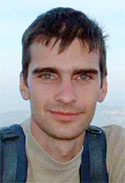You are here
CMOP Publishes Use of Data Assimilation for Optimal Observation in a Coastal Observatory
01/20/09 Portland, Ore.
 Continental Self ResearchThe complexities of the Columbia River estuary and plume present a challenge for scientists to find the best place to take measurements. This is a dynamic and challenging environment to study and scientists want to better manage where they place fixed observational assets.
Continental Self ResearchThe complexities of the Columbia River estuary and plume present a challenge for scientists to find the best place to take measurements. This is a dynamic and challenging environment to study and scientists want to better manage where they place fixed observational assets.
A recent publication in Continental Shelf Research co-authored by Sergey Frolov, Ph.D., graduate of Oregon Health & Science University (OHSU), reports on the use of data assimilation for optimal observation in the Columbia River estuary.
"Optimizing Fixed Observational Assets in a Coastal Observatory" is one of three recent publications by Frolov and colleagues* at the Center for Coastal Margin Observation & Prediction (CMOP).
Their work in the Columbia River estuary and plume suggest that algorithms for optimal placement of sensors are reaching maturity and likely to play a significant role in the design of emerging ocean observatories.
Frolov came to OHSU in September 2001 to study Environmental Information Technology. His adviser, António Baptista, Ph.D. worked with him to analyze the problems of data assimilation and optimal observation in the Columbia River estuary.
“We decided on the approach of probabilistic data assimilation to help inform us where in the Columbia River our uncertainty about the physical flow is greatest," Baptista said. "This data will help us optimally place our observing instruments in the estuary and plume."
Frolov participated in the development of the Columbia river data assimilation system led by professor Todd Leen, Ph.D. and his group in OHSU's Computer Science and Electrical Engineering Department.
"Our system forms a Bayesian (probabilistic) fusion of the numerical model predictions with the measurements to increase modeling accuracy even at places where there are no measurements," Leen said. "Such data assimilation is crucial to accurate modeling in coastal margins where the dynamics are highly variable."
Frolov's collaboration with Leen's research group helped develop an extremely fast model surrogates that accelerate the modeling process by 1-12 thousand times as required for the data assimilation system.
 Today, Frolov continues his research in coastal observatories as a postdoctoral fellow at Monterey Bay Aquarium Research Institute (MBARI). He is designing MBARI‘s ocean observatory for observing and predicting harmful algal blooms (red-tides) in Monterey bay, California.
Today, Frolov continues his research in coastal observatories as a postdoctoral fellow at Monterey Bay Aquarium Research Institute (MBARI). He is designing MBARI‘s ocean observatory for observing and predicting harmful algal blooms (red-tides) in Monterey bay, California.
Frolov would like to see coastal ocean observatories become ubiquitous and contribute greatly to the health of the people and strength of the ocean economy. He hopes to contribute by developing a new generation of ocean models.
“Such models will continue integrating the increasing number of diverse oceanographic data into a predictive realization of the biological and physical ocean,” Frolov said.
*Additional study authors include principal investigator Antonio M. Baptista, Ph.D. and senior research associate, Michael P. Wilkin.
Written by Jeff Schilling
###
Frolov, S, Baptista A, Zhang Y, Seaton C. 2009. Estimation of ecologically significant circulation features of the Columbia River estuary and plume using a reduced-dimension Kalman filter. Continental Shelf Research. 29(2):456-466.






